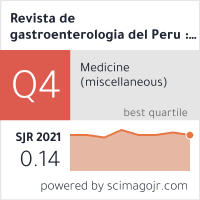Metagenomic analysis of the gastric microbiota cultivable from a patient with gastritis concomitant with Barrett’s esophagus
DOI:
https://doi.org/10.47892/rgp.2014.343.158Palabras clave:
Barrett esophagus, Gastritis, Microbiota, Bacteroides fragilisResumen
Barrett’s esophagus is a distal metaplasia characterized by the transformation of squamous mucosa into columnar mucosa. This esophageal phenotype is a product not only of the chronic reflux of gastric acids, but also by microorganisms that colonize the oral cavity and stomach. Two classes of microbiota can be identified in Barrett’s esophagus; microbiota type I is associated with the normal esophagus and type II with an inflamed esophagus. The present study describes the gastric microbiota of a patient with antral gastritis concomitant with Barrett’s esophagus absent infection with Helicobacter pylori. Gastric biopsies were obtained following the protocol of Sydney and following ethical practices. The isolates were cultivated under microaerophilic conditions on Columbia Agar supplemented with IsoVitaleX™ and 7% sterile blood. Extracted DNA was sequenced using 454-GS and the results analyzed on the MG-RAST server. Gram negative isolates were found and bacteria resistant to levofloxacin, amoxicillin, tetracycline, erythromycin, and clarithromycin. The phyla Bacteroidetes, Firmicutes, Fusobacteria and Proteobacteria, the genus Bacteroides and the species group Bacteroides fragilis were most abundant. Functionally, the metabolism of carbohydrates, amino acids, and to a lesser extent, the metabolism of cofactors and vitamins were most dominant, and of which the enzymes β-glucosidase (EC 3.2.1.21), β-galactosidase (EC 3.2.1.23) and β-N-acetylhexosaminidase (EC 3.2.1.52) were most dominant. The findings of this study, because they are of only one case may probably suggest a possible pathogenic role, previously undescribed for Bacteroides fragilis, associated with human gastritis when concomitant esophageal pathology exists.Descargas
Los datos de descargas todavía no están disponibles.
Métricas
Cargando métricas ...
Descargas
Publicado
09.06.2017
Cómo citar
1.
Gutiérrez-Escobar AJ, Bayona-Rojas M, Barragan-Vidal C, Rojas-Lara S, Oliveros R. Metagenomic analysis of the gastric microbiota cultivable from a patient with gastritis concomitant with Barrett’s esophagus. Rev Gastroenterol Peru [nternet]. 9 de junio de 2017 [citado 18 de diciembre de 2025];34(3):229-35. isponible en: https://revistagastroperu.com/index.php/rgp/article/view/158
Número
Sección
REPORTES DE CASOS
Licencia
Revista de Gastroenterología del Perú by Sociedad Peruana de Gastroenterología del Perú is licensed under a Licencia Creative Commons Atribución 4.0 Internacional..
Aquellos autores/as que tengan publicaciones con esta revista, aceptan los términos siguientes:
- Los autores/as conservarán sus derechos de autor y garantizarán a la revista el derecho de primera publicación de su obra, el cuál estará simultáneamente sujeto a la Licencia de reconocimiento de Creative Commons que permite a terceros compartir la obra siempre que se indique su autor y su primera publicación esta revista.
- Los autores/as podrán adoptar otros acuerdos de licencia no exclusiva de distribución de la versión de la obra publicada (p. ej.: depositarla en un archivo telemático institucional o publicarla en un volumen monográfico) siempre que se indique la publicación inicial en esta revista.
- Se permite y recomienda a los autores/as difundir su obra a través de Internet (p. ej.: en archivos telemáticos institucionales o en su página web) antes y durante el proceso de envío, lo cual puede producir intercambios interesantes y aumentar las citas de la obra publicada. (Véase El efecto del acceso abierto).
















 2022
2022 